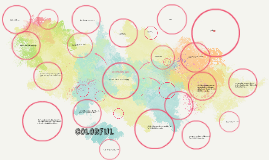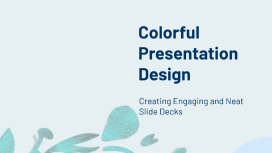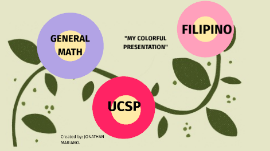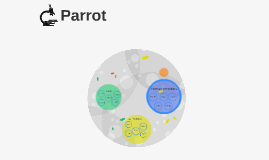Colorful Presentation Design
Transcript: Colorful Presentation Design Essential Elements of a Neat Presentation Key aspects that contribute to maintaining a clean, professional appearance in presentations include color schemes, font choices, layout structures, and more. Understanding how each element influences the overall effectiveness is crucial. Alignment and Spacing Proper alignment and spacing enhance readability and visual appeal. Align text and images uniformly to create a clean look. Utilize white space effectively to avoid clutter and improve focus. Creating Engaging and Neat Slide Decks Layout Structure Consistent Color Scheme Visual Hierarchy A well-structured layout organizes content effectively, aiding in information retention. Use grid systems to ensure consistent alignment across slides. Limit the amount of text per slide to maintain audience engagement. Establishing a visual hierarchy guides the viewer's attention through the content. Utilize size, color, and placement to signal importance. Prioritize key information by using larger fonts or bolder colors. A consistent color scheme establishes visual harmony and strengthens brand identity. Use 2-3 main colors that reflect the theme and message. Ensure sufficient contrast between background and text for readability. Font Selection Selecting appropriate fonts contributes to overall readability and aesthetic appeal. Choose easily readable fonts for body text (e.g., Arial, Helvetica). Use decorative fonts sparingly and only for headings to maintain focus. Adjusting Based on Audience Use of Images Tailor your content and delivery style to the audience's level and interests. Research your audience to anticipate questions and areas of interest. Be prepared to modify your approach based on audience reactions during the presentation. Infographics • High-quality images capture attention and reinforce messaging. • Visuals should be relevant to the content, enhancing comprehension instead of distracting from it. • Infographics simplify complex data into easily digestible visuals. • Effective use of colors, icons, and layout can significantly boost information retention. Getting Feedback Preparing for Q&A Videos and Animations Charts and Graphs Creating Engaging Visuals Constructive criticism can significantly enhance your presentation. Present to peers for insights on content clarity and engagement. Utilize questionnaires to gather structured feedback post-practice. Anticipating potential questions enhances your credibility. Prepare thoughtful answers to common questions related to your presentation. Practice a calm and confident demeanor to engage effectively during Q&A sessions. • Videos can convey stories and demonstrate concepts in a dynamic way. • Animations can highlight key points and maintain audience interest, but should be used sparingly to avoid distraction. • Charts provide a visual summary of numerical data, making trends and comparisons clear. • Bar graphs, line graphs, and pie charts are commonly used to represent different types of data effectively. Practice Delivery Visual elements enhance audience retention and understanding. Engaging visuals can transform complex information into understandable insights. Consistency in Visuals Tips for Finalizing Presentations • Consistent use of colors, fonts, and styles enhances professionalism. • A cohesive visual identity helps in brand recognition and keeps the audience focused on the message. Rehearsing improves confidence and presentation flow. Practice in front of a mirror or record yourself to refine gestures and tone. Time your presentation to ensure it fits within the allotted time frame. Reviewing Content Effective finalization of presentations ensures clarity and confidence. Proper preparation can transform a good presentation into a memorable one. Ensure all slides convey key messages clearly and concisely. Check for grammatical errors, typos, and factual inaccuracies. Confirm consistency in design elements and overall presentation flow. Contrast and Readability High contrast between text and background improves readability: Dark text on a light background or vice versa Avoid using similar colors that blend together Ensures key information stands out for greater audience retention. Visual Appeal Complementary Colors Aesthetically pleasing presentations attract and hold attention. Use a harmonious color palette and consistent fonts to create a cohesive look. Images and graphics can enhance storytelling and evoke emotions. Color Combinations Complementary colors enhance visual appeal by creating contrast: Found opposite each other on the color wheel Examples: Blue and orange, red and green Using these colors together creates a dynamic yet harmonious look. Effective color combinations enhance the visual storytelling: Use three to five colors maximum for cohesion Tools like Adobe Color can aid in selecting harmonious palettes Consistent use of color combinations strengthens brand identity. Clarity of Information Audience Engagement

















